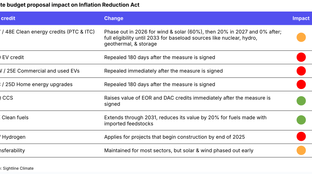
🌎 Overheard at LCAW #252
Climate, capital, and carrots in London's new playbook
How the grid failed in Texas and why Dandelion is making geothermal mainstream
Happy Monday! In this week’s issue, we loop up with Breakthrough Energy Ventures’ latest investment, Dandelion Energy, on their moonshot quest to propel us towards a geothermal energy future.
In contrast, we also go deep on the math and mania behind Texas’ unfortunate cold spell, and how systematic disinvestment in energy resilience (and not the Green New Deal) has led to a massive underpreparedness for climate swings.
We also share some other exciting new raises, like 3D printed meat and electric school buses, as well as an investor role at, literally, Climate Capital.
Thanks for reading!
Not a subscriber yet?
Devastating freezing temperatures and winter storms cascaded through central and southern US last week - and hit Texas especially hard. The state’s power grid buckled under the high demand for electricity, and millions lost power - just as they needed heat the most.
This won’t be the last extreme weather event to test our electric grids’ resiliency and reliability. At the very least we must:
☔️Weatherize energy facilities and homes with insulation or more durable materials
🔋Expand energy storage options with batteries and distributed energy resources
🔄Localize energy distribution through microgrids and renewable sources
But all of this grid modernization will take money, you say. We used the back of an envelope and calculated that the cost of a marginal 1MW for the full 5 days during the peak of the storm cost the equivalent of a full year’s 1MW solar power plant.
Lucrative investment schemas aside, what happened in Texas this week?
Weather: The climate change-induced warming Arctic potentially catalyzed the deep freeze in Texas. At the beginning of the year, an event unfolded in the Arctic called Sudden Stratospheric Warming (SSW), which caused trapped cold air to plunge much further south than typical – 4,000 miles from its usual North Pole home to Texas.
Electricity generation: Natural gas couldn’t handle the cold. Texas’ electricity is generated from four energy sources: 54% natural gas, 19% coal, 18% renewables (primarily wind), and 9% nuclear. Not built to withstand the frigid temperatures, natural gas wellheads and wind farms froze (with the impact of natural gas on electricity generation dwarfing wind by a factor of 5-6). Beyond wellheads becoming dysfunctional, natural gas was diverted to heat homes. Of the 30 GW gap needed to meet electricity demand on February 15, 87% was from natural gas and 13% from wind.
Electricity operators: There’s no better example of Texas’ desire for independence than the Electric Reliability Council of Texas (ERCOT) – America’s only independent electrical service. ERCOT serves as the grid operator, matching electricity supply and demand to ensure the availability of backup power to critical infrastructure. As power generation dipped below the expected worst-case scenario, ERCOT called for rolling blackouts to keep supply and demand in line.
Electricity market: Officials do not require providers to prepare for the worst and rather expect the prospect of high prices during peak demand to incentivize providers. As we know now, that did not happen. A fundamental design in Texas’ electricity market is that power providers can profit from supplying electricity to customers but are not required to do it. They face no penalties for failing to deliver power, even during an emergency.
🚌 Highland Electric Transportation, a Hamilton, MA-based electric school bus maker, raised $253m in funding from Vision Ridge Partners, Fontinalis Partners and existing investors. More here.
🌋 Eavor, a Canada-based geothermal energy startup, raised $40m in funding from Chevron Technology Venture, BP Ventures, Temasek, BDC Capital, and others. More here.
🌋 Dandelion Energy, a Peekskill, NY-based geothermal company, raised $30m in Series B funding from Breakthrough Energy Ventures, GV, NEA, Lennar Corporation, Collaborative Fund, and Building Ventures. More here.
🥩 Redefine Meat, an Israel-based 3D-printed alternative meat startup, raised $29m in Series A funding from Happiness Capital, Hanaco Ventures, and CPT Capital. More here.
🚲 SUPER73, an Irvine, CA-based electric bike company, raised $20m in funding from Volition Capital. More here.
🌱 EnginZyme, a Sweden-based maker of tech in the sustainable production of chemicals, raised $5.3m in extended Series A funding from Industrifonden, and SEB Greentech VC. More here.
♻️ Rheaply, a Chicago, IL-based startup focused on recycling unused items, raised $8m in Series A funding from High Alpha, 100 Black Angels & Allies Fund, Hyde Park Angels, M25, MCJ Collective, Revolution’s Rise of the Rest Fund, and Salesforce Ventures. More here.
🌲 Modvion, a Sweden-based sustainable wood technology company, raised an undisclosed amount from Vestas Ventures. More here.
Origin Materials, a Sacramento, CA-based maker of “carbon-negative products,” agreed to go public at a $1.8b valuation via reverse merger with SPAC Artius Acquisition. More here.
Li-Cycle, a Canadian recycler of lithium-ion batteries, agreed to go public at a $1.7b valuation via reverse merger with Peridot Acquisition Corp a SPAC formed by Carnelian Energy Capital. More here.
Volta Energy Technologies, an Illinois-based energy VC firm, has raised $90m of a new $150 million-targeted VC fund to back energy storage startups. More here.

We chatted with Kathy Hannun (President & Co-founder) and Michael Sachse (CEO) of Dandelion Energy about how they turned a moonshot idea for geothermal heating and cooling into the most recent company to be backed by Breakthrough Energy Ventures. With 500+ home installations to date, Dandelion is powering grid resiliency by bringing geothermal to people’s backyards. [We edited the newsletter version lightly for length; read the full interview here].
What led you to start Dandelion Energy?
Dandelion started when I (Kathy) was at Alphabet’s innovation lab, X, and hunting for moonshot opportunities to apply mission-aligned technology to big problems in the energy space. Before landing on the idea that became Dandelion, I had been working on Project Foghorn - a new production mechanism to produce carbon neutral methanol by combining seawater and renewable hydrogen. It worked, but ultimately the risk profile and costs were too high to build a business from it. Coming out of that project, I was looking for a commercialization-ready technology where costs made sense - geothermal checked those boxes.
Like most people, I didn’t know too much about geothermal at first, but the large fraction of energy used to power consumers’ homes caught my attention - it’s right up there with transportation. All of this attention is directed towards electrifying transportation, while very little time or effort is going into electrifying heating.
We quickly realized that Dandelion was better suited to be a standalone company versus an Alphabet-internal division given the nature of the product and need to iterate and improve quickly by going to market. After spinning Dandelion out of X and growing the business for about 3 years, I brought in Michael who had previously run OPower and been an entrepreneur in residence at NEA. My passion is in R&D, while Michael’s unique skill set is in complex operations - so it’s been a really great fit so far.
So what does Dandelion Energy do?
Dandelion installs geothermal heating and cooling systems in homes. We make geothermal heating and cooling affordable and widely available. Our homeowners in the Northeast used to burn propane, fuel oil, or natural gas in their boilers for heat. By switching to geothermal, they save money on heating and cooling - and switch to an emissions-free system. We put ground loops in their yard, connect them to a heat pump where their furnace used to be, and then our customers have a renewable heating and cooling solution - which also provides half of their hot water.
What is the climate impact of switching from home heating with oil to heating with geothermal?
In order for Breakthrough Energy Ventures to invest, a company must demonstrate the potential to remove at least 500 megatons of carbon each year. Our eyes are on that goal. Simply put, for anyone living in the Northeast’s colder climate, switching to geothermal home heating is the single most significant thing that you can do to reduce your carbon footprint.
How are the benefits and challenges of geothermal versus other renewable heating and cooling solutions?
When it comes to heating and cooling systems, there are three choices:
How does Dandelion’s technology work?
We’re different from other geothermal players in a few ways. We first started experimenting with methods of ground loop installation that’re appropriate for a residential setting. In the past, water well rigs were appropriated to install ground loops. That, or you’d literally bring in an excavator to dig a big swimming pool-sized hole in the ground, complete with all of the noise, mud, and chaos. Dandelion’s target customers are suburban homeowners with nice yards where these methods don’t work. We’ve created a small modular drill for our low impact process that’s custom built for residential geothermal. Our suite of equipment is designed to work across different geologies, while being confined to tight installation areas. It takes just a few people to operate the process which helps keep costs low for the homeowner.
The next thing is the heat pump itself. Geothermal has historically been a niche luxury market, so heat pumps haven’t been designed as a mainstream product. Our scale means that we’ve created a higher-value heat pump that has full monitoring capabilities as well.
And finally, we’ve made the customer experience much simpler. We manage the project end to end with a dedicated account manager. Homeowners are abstracted from the complexity of the install and don’t have to worry about any of the legwork to ensure their geothermal system works.
How does financing for residential geothermal work? How does it compare to the residential solar leasing model?
We provide financing for our customers which means that from day one they see a lower energy bill. We’re really focusing on improving financing options, and will get better as we build up more proof points in this market. The solar industry has done a really good job of creative financing and bringing this cost down for customers. We’re actively looking at the solar leasing model and exploring how to replicate that in geothermal. It will be an iterative process where we bring proposed models to potential funders and work off their feedback. There’s also a legal component that we have to define in geothermal - a solar company can reclaim their panels if the homeowner doesn’t pay - but obviously it’s more challenging to reclaim a heat pump or ground loops.
You just raised a $30m Series B round led by Breakthrough Energy Ventures. Congratulations! What does the future look like for Dandelion?
We’re thrilled that BEV, Bill Gates’ climate fund, led our Series B and that all of our prior investors participated. Our plan is to begin expanding geographically - into Long Island, further in Connecticut and Massachusetts - and to really double down on our R&D. With our fast pace of growth, we’ve been caught up in meeting customer expectations. With this funding, we’ve reached a scale where we can separate our long-term product vision from servicing customers day-to-day. We’ve got a lot of experiments we want to run, and have been waiting for the capacity to do it.
Curious about how you or a friend with property in the Northeast can switch to geothermal? Head to Dandelion’s website to see if your home qualifies. Likewise, the company is always looking for drillers to join the team - or, one better, water well drilling companies in the Northeast. If you hold the magic ticket, email us right away!
IBM is the latest tech giant to announce a 2030 net zero commitment. Much of IBM’s decarbonization approach will come via powering its data centers with renewables and potentially offsetting with carbon capture.
With the good days behind it, Shell says that it has peaked - oil production, that is. From 2019 on, Shell’s oil production will fall and be replaced by renewable sources.
Prominent economists Nicholas Stern and Joseph Stiglitz published a paper arguing that the social cost of carbon – a number that greatly influences climate action – is too low. The economists point to systematic biases in Integrated Assessment Models which overestimate costs and underestimate benefits.
The EV Automakers’ Super Bowl continues with Ford’s announcement that its entire European vehicle range will be “all electric” by 2030 and Jaguar’s commitment to roll out all-electric models by 2025. Despite legacy automakers’ Hail Marys, Tesla produced a whopping 79% of all US registered EVs in 2020.
We tease a future feature on “what’s different this time” between Climate Tech vs Cleantech 1.0 on last week’s episode of the Wharton Current podcast.
Bill Gates released his highly anticipated book “How to Avoid a Climate Disaster” – rightly highlighting and encouraging climate tech breakthroughs but wrongly limiting his political purview.
America Is All In to meet our Paris obligations by reaching net zero by 2050, via the most expansive coalition of climate leaders ever assembled. Thousands of cities, states, tribal nations, businesses, schools, and faith, health, and cultural institutions will work alongside the Biden Administration to develop a national climate strategy.
Electric motorboats make a wake, while Taiga’s electric jet skis ride the SPAC wave.
💡 Elemental Connect: Elemental Excelerator launched a new platform to connect climate tech startups and investors in collaboration with FounderNest. Join as a founder or investor.
💡 Terra.do: Join the next 12-week online climate bootcamp on ‘everything climate’ which has graduated hundreds already. Starts March 4th, last date for applications is Feb 28th. There are a few 100% scholarships available.
🗓️ Women of Climatetech - Access to Success: Join Greentown Labs and Los Angeles Cleantech Incubator on March 4th for a workshop featuring female founders and investors in climate tech.
🗓️ ClimateTech Jobs Fair: Register for live 1:1 conversations with software, data science, product management, and hardware hiring manager at top climate tech companies on March 5th.
🗓️ Activate Eco: Apply by Feb 28th to this life sciences accelerator focused on forming ventures between scientists and business students to solve climate change.
Program Coordinator @Drawdown Lift
Chief of Staff @Sealed
CSR Supply Chain Manager @Impossible Foods
Operations Manager; Talent Manager @The Future Forest Company
Aquaculture Technician @Upward Farms
Statistical Scientist @Cervest
Software PM @Borrego Energy
ESG Analyst @Bank of America
Investor @Climate Capital
Feel free to send us new ideas, recent fundings, or general curiosities. Have a great week ahead!

Climate, capital, and carrots in London's new playbook

US plays popcorn politics with biofuels and beyond

Groundbreaking results from the geothermal developer’s main project